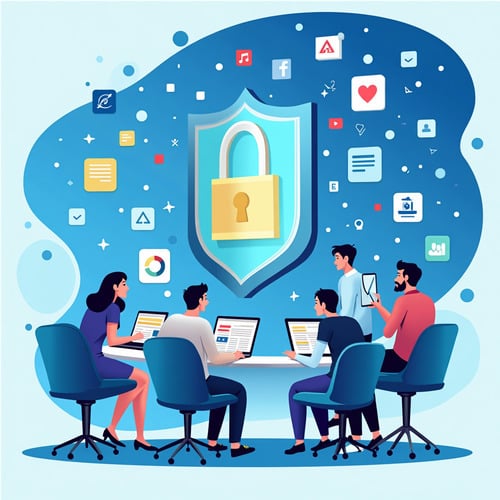What Transformations Are Shaping the Role of the "New Communication Directors"?
 On 20 May, 2025
On 20 May, 2025

Digitalization is driving communication directors to work in constant immediacy while strengthening the cross-functional nature of their role. Their increasingly broad skills consolidate their strategic and analytical importance, blurring the boundaries between internal and external communication.
The digital transformation of businesses and the influence of social media on public opinion are revolutionizing the field of communication. Amid these upheavals, one profession continues to evolve: that of the Communication Director. Predating the widespread digitalization of the 2000s, the "DirCom" now faces diverse responsibilities, including online brand image, SEO, crisis communication, advertising campaigns, internal communication, employee advocacy, and media relations. Whether in the public or private sector, communication directors have become indispensable figures across industries, acting as increasingly complex and multifaceted conductors.
What Communication Methods for DirComs?
From tweets to Facebook posts, information can spread rapidly within minutes. Digitalization has primarily accelerated communication modes.
« What has profoundly changed in my daily life is immediacy—it forces us to constantly work in crisis mode. This has become our standard approach, which we must rethink in light of this immediacy. » Frédéric Fougerat (Communication Director at Foncia)
« Previously, our key audience was opinion leaders. Over recent years, this has expanded to include users and clients with whom we engage daily. Social media has reshaped everything, enabling them to express opinions about our services 24/7—a profound shift for our profession and how we build our company’s reputation » explains Delphine Penalva (Communication Director at Solocal).
« The speed at which we communicate and the proliferation of channels demand greater coherence and increasingly radical and disciplined choices. », Béatrice Mandine (Communication Director at Orange).
« Our role as conductors is crucial. Employees now have easy access to technology and may feel empowered by their online influence. If we fail to convince them of the importance of consistent corporate communication, we risk losing them. », explains Jérôme Chambin (Communication Director at GRDF).
The accelerated pace of communication has broadened the scope of topics DirComs address. This cross-functional approach is now essential.
« Over time, my role has evolved from a support function to a strategic one. », Frédéric Fougerat (Foncia).
« This notion of cross-functionality is fundamental to our mission. This is all the more important because we are still sometimes seen as a partner who comes in at the end of the chain. Yet, we need to have information as early as possible », continues Nathalie Lahmi (Dircom d'Allianz France).
To better achieve this cross-functionality, she brings together groups of ten people from various fields (business, marketing) so that they can develop communication projects together.
“Cross-functionality should allow us to work coherently and coordinate our communication actions in order to strengthen the brand image,” she elaborates.
Cross-functionality and strategy for the DirCom role
Such a high degree of cross-functionality leads communication directors to question the exact scope of their activities. «In some cases, we move from communication to marketing. When we have to analyze everything being said on social networks to develop a project, we are moving far away from pure communication. We play a role of anticipation and analysis that is becoming very important », analyzes Olivier Dery (Dircom d'Ariane Group).
« I find that, on the contrary, in my company communication is quite well distinguished from marketing. My job is to reconstruct a coherent brand image. The brand is a tool I am responsible for, a tool I take care of so that marketing can sell as effectively as possible,” responds Béatrice Mandine (Orange). “Marketing and communication are two different domains, but it is true that they are coming closer together and the boundaries are sometimes quite blurred », finally nuances Nathalie Lahmi (Dircom d'Allianz France).
« It’s a profession that has greatly expanded, with a broadening of skills. We must learn to have shareable roles, to accept that others come onto our turf and vice versa. » Marianne de Battisti (Dircom d'ICADE)
Coherence and engagement
The main challenge for a communications director is the ability to deliver a coherent message, whether in advertising, press interviews, or internal communication.
« The topics we address are increasingly numerous. And we have to decide which channel to use to disseminate information that is initially unique », says Alexia Lefeuvre (Dircom de Rakuten).
« What ultimately matters is the image. That’s what we must protect and strengthen », summarizes Julien Goubault (Dircom de Klepierre)
« Whatever the channels and the level of publicity, there must be one single message everywhere. Otherwise, there is no coherence, and therefore no strength. » Julien Goubault (Dircom de Klepierre)
One of the direct consequences of accessibility to platforms is how easily employees can speak out about the company’s activities. The risk is that this may blur the coherence of messages. Difficult to control, this speech is increasingly anticipated upstream through employee advocacy. This is the mechanism by which the company mobilizes its employees to become ambassadors, both inside and outside their work environment.
« Internally, by cultivating employee advocacy, we have moved to engagement-driven communication. Digitalization has reinforced this aspect of internal communication. It enriches our role and generates interest among executives, as it fosters pride in being part of the company, especially among the younger generations entering the market with a certain detachment », explains Jérôme Chambin (Dircom de GRDF).
« Today, we are constantly collaborating. When you are the most cross-functional element in the company, the best service you can provide to management is to maintain this collaborative spirit. If things go well internally, it will be felt externally. Employees will seek out information and coherent messages to relay », continues Marianne de Battisti (Dircom d'ICADE).
« Our role is to give meaning to engagement within a purpose and an industry. Employees are above all attached to the brand. The service I must provide to the company is to generate engagement around the management’s message », ajoute Jérôme Chambin (Dircom de GRDF).
To foster this engagement, GRDF, for example, relies on an internal corporate social network created in 2010. Today, it boasts 10,500 registered users out of 12,000 employees and an 85% usage rate. The company has also created a Twitter feed where about 4,500 employees share photos of their work in the field.
« We are a company without significant communication resources, yet we have highly engaged employees whom we know how to mobilize », analyzes Jérôme Chambin.
« Today, our employees are very understanding; they have realized that all this is in the interest of the business », ajoute Alexia Lefeuvre (Dircom de Rakuten).
« Our transformation projects are participatory, and we create working groups to carry them out. Within these cross-functional teams, everyone thinks very early on about how they will communicate about what they are doing. Giving everyone a voice is useful and inspiring, but it is a priority to focus on the substance of the work and its operational quality before immediately talking about a communication plan » nuances Delphine Penalva (Dircom de Solocal).
Social Media and GAFA Are Game-Changers
With the central involvement of employees in new strategies, internal communication now directly falls within the scope of communication directors. This blurs the boundaries with external communication.
« Today, internal communication is part of my remit, and there is real permeability between internal and external. We no longer make any distinction in organizational terms; we talk about content management », says Anne-Elisabeth Mourey (Dircom de Solvay).
«In a company like ours, internal communication is a crucial but difficult challenge, as we have reached the point where we have five generations of employees to harmonize », explains Nathalie Dray (Dircom de Walt Disney Company).
« When you see internal teams responding to users on social media to spontaneously defend the company, you realize that our profession has been profoundly transformed. » Delphine Penalva (Dircom de Solocal)
Today, employees are able to express themselves about their work. But with the new levels of interaction between the company, users, and clients, social networks are blurring these boundaries. Internal and external communication are now much more intertwined. From social data to monitoring and advertising, the opportunities they offer are measured with pragmatism.
« Today, it’s less about monologue. Social media allow us to come with quantitative data, to identify strategies that work, to anticipate trends and crises. », says Olivier Dery (Dircom d'ArianeGroup).
« In companies where communication has long been undervalued, we will need even more metrics. And for that, technological advances are a real asset. They allow us to be more precise and more convincing », adds Nathalie Lahmi (Dircom d'Allianz France).
With social listening tools, companies can measure the effectiveness of their communication, identify trends or crises. For example, Allianz sends its management a monthly e-reputation report.
« We report the number of mentions, but also the tone of the topics discussed and the level of audience engagement. This always sparks discussion, as executives sometimes have a different perception with their own monitoring. For example, we are not always the leaders in terms of mention volume, but we have very positive results regarding the tone and engagement level of those mentions », says Nathalie Lahmi (Dircom d'Allianz France).
«You need to pay attention to social media, but what happens there is not always essential. For me, it’s the difference between chatter and speech. Writing a speech remains our core business and our main skill », nuances Julien Goubault (Dircom de Klepierre).
« For me, the challenge is precisely to make social media more than just chatter. Thanks to our employee advocacy, we have an impressive quality of discourse on social networks. Writing a speech is one thing, but it’s even harder to ensure that people make it their own and share it », nuances Nathalie Dray (Dircom de Walt Disney Company).
« Relying only on people who speak out on social media is not enough. You have to offer content. We quickly moved from a time when we posted on Facebook every ten days to ten posts a day. So we need increasingly specialized people for each channel, and we’re considering narrow artificial intelligence for content creation,. » Anne-Elisabeth Mourey (Dircom de Solvay)
Beyond digitalization, the role of communication director has also been upended by the arrival of the GAFAs, with a very specific mode of communication, notes Jérôme Lascombe (Communications Director at Wiztrust). For example, in the aerospace sector, the Ariane group was challenged by the arrival of Elon Musk’s SpaceX rockets, Facebook’s Titan drones, and many others.
« In the face of these players, we can’t remain silent. Elon Musk can communicate lightly about his failures, while we can’t necessarily afford to do the same. The main difference is that our leaders are employees. Yet GAFA bosses are personalities who embody their companies and can do as they please without worrying too much about shareholders. Ultimately, the fact that they are so emblematic forces everyone else to take a stand. In terms of messaging, it pushes us, », analyzes Olivier Dery (Dircom d'ArianeGroup).
« It’s true that the presence of such iconic leaders changes the game. But it also creates a different corporate culture. My counterparts at the GAFAs have almost zero room for maneuver. I’ve only seen them move in one very narrow direction. The cultural limit of this model is that they can’t afford crises like Facebook’s Cambridge Analytica or Google’s GDPR issues », adds Marianne de Battisti (Dircom d'ICADE).
The role of Communication Directors is constantly evolving through technological advancements and shifting organizational dynamics. These transformations highlight how industry sectors and corporate cultures shape their activities uniquely.


 9 min
9 min
